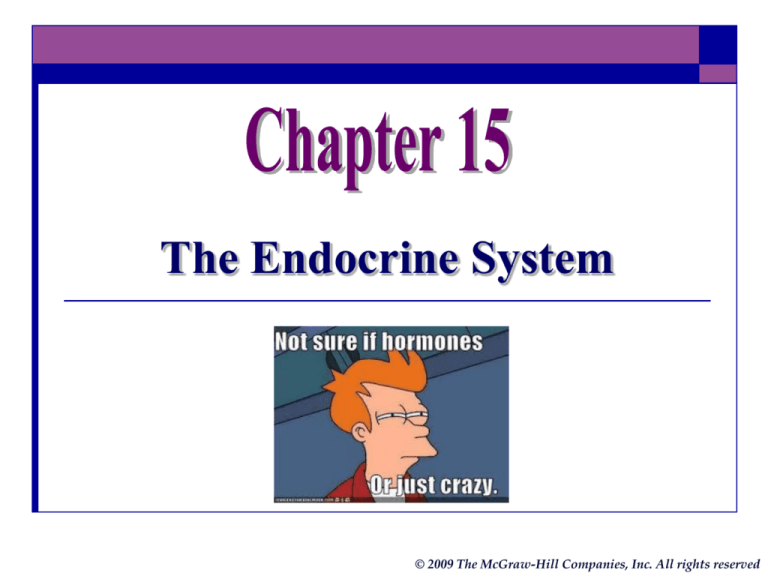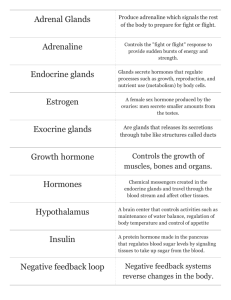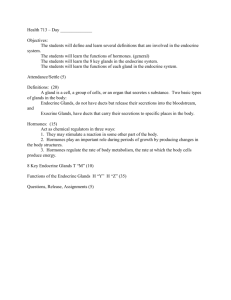
The Endocrine System
© 2009 The McGraw-Hill Companies, Inc. All rights reserved
34-2
Introduction
The endocrine system includes the organs of the
body that secrete hormones directly into body fluids
such as blood
Regulates chemical reaction in cells and therefore control
functions of the organs, tissues, and other cells
bloodstream
to
Glands
into
secrete
hormones
target tissues
© 2009 The McGraw-Hill Companies, Inc. All rights reserved
34-3
Hormones
Endocrine glands
Ductless
Release hormones
Directly into target tissues
Into bloodstream to be carried to target tissues
Hormones – chemicals secreted by a cell that
affect the functions of other cells
© 2009 The McGraw-Hill Companies, Inc. All rights reserved
34-4
Hormones (cont.)
Many are derived from steroids that easily
cross the cell membrane
Examples of steroid hormones
Estrogen
Progesterone
Testosterone
Cortisol
hormones
© 2009 The McGraw-Hill Companies, Inc. All rights reserved
34-5
Negative and Positive
Feedback Loops
Control hormone levels
Negative feedback loop
Hormone release stops in response to decrease in
stimulus
A person becomes dehydrated
Brain signals the release of Antidiuretic Hormone
(ADH)
Kidneys retain water.
Kidneys excrete more urine until the concentration of
fluids returns to normal.
© 2009 The McGraw-Hill Companies, Inc. All rights reserved
34-6
Negative and Positive
Feedback Loops (cont.)
Positive feedback loop
As long as stimulus is present, action of hormone
continues
Infant nursing at mother’s breast stimulates
hypothalamus stimulates posterior pituitary
Oxytocin released stimulates milk production and
ejection from mammary glands
Milk release continues as long as infant continues to
nurse
© 2009 The McGraw-Hill Companies, Inc. All rights reserved
34-7
Hypothalamus
Hormones
Oxytocin – Stimulates contractions of uterus
during labor
Antidiuretic hormone (ADH) – stimulates
conservation of water during dehydration.
Hormones transported to the posterior
pituitary for storage
Glands
Directs posterior pituitary to release hormones
© 2009 The McGraw-Hill Companies, Inc. All rights reserved
34-8
Pituitary Gland
Controlled by the hypothalamus
Located at the base of the brain
Anterior lobe secretes many hormones, including:
Growth hormone (GH) – controls cellular
reproduction and regulates use of carbs and fats.
Thyroid-stimulating hormone (TSH) – stimulates the
metabolism of ALL tissues in the body.
Folicle-stimulating hormone (FSH) – production of
reproductive cells
Prolactin (PRL) – production of milk in mammals
Glands
© 2009 The McGraw-Hill Companies, Inc. All rights reserved
34-9
Pituitary Gland (cont.)
Oxytocin
Posterior
Lobe
Antidiuretic hormone (ADH)
Stimulates the kidneys to
conserve water
Females: causes
contraction of the
uterus and ejection of
breast milk
Males: stimulates
contraction of the
prostate and vas
deferens during
sexual arousal
© 2009 The McGraw-Hill Companies, Inc. All rights reserved
34-10
Thyroid Gland and
Parathyroid Glands
Thyroid Gland
Located below the larynx (houses vocal cords)
Divided into follicles that store some of the hormones
Major hormones
T3 T4
Stimulate protein synthesis and
increase cellular energy
production
Lowers blood calcium levels
by activating osteoblasts that
Glands
build new bone tissue
© 2009 The McGraw-Hill Companies, Inc. All rights reserved
34-11
Thyroid Gland and
Parathyroid Glands (cont.)
Parathyroid glands
Four located on the posterior surface of the
thyroid gland
Secrete parathyroid hormone (PTH)
Raises blood calcium levels through activation of
osetoclasts (dissolve bone)
As bone dissolves, calcium levels in blood increase
Glands
© 2009 The McGraw-Hill Companies, Inc. All rights reserved
34-12
Adrenal Glands
Located on top of each kidney
Divided into the adrenal medulla and adrenal cortex
Adrenal medulla
Central portion
Hormones
Epinephrine – Adrenaline, response to stress
Norepinephrine – works with epinephrine during
stress events to bring the body back to homeostasis
Glands
© 2009 The McGraw-Hill Companies, Inc. All rights reserved
34-13
Pancreas
Located behind the
stomach
Both exocrine gland and
endocrine gland
Exocrine – secretes
digestive enzymes into a
duct leading to the small
intestine
Endocrine – secretes
hormones into
bloodstream
Glands
© 2009 The McGraw-Hill Companies, Inc. All rights reserved
34-14
Insulin
Protein hormone secreted by the pancreas that stimulates
cells to take up glucose
Glucose – primary source of cellular energy
Gives the brain energy for psychological
processes.
Body converts the glucose into glycogen for long
term storage of energy.
What happens after you eat a large meal?
Pancreas secretes insulin, which results in a decrease
in blood levels of glucose.
© 2009 The McGraw-Hill Companies, Inc. All rights reserved
34-15
What is Diabetes?
Diabetes insipidus Kidneys fail to reabsorb water, resulting in
excessive urination; hyposecretion of ADH
Diabetes mellitus
Chronic disease characterized by elevated
blood glucose levels
Type I
Insulin-dependent diabetes mellitus; usually develops
in childhood
Noninsulin-dependent diabetes mellitus; primarily in
adults but increased incidence in teens
Occurs during pregnancy; usually temporary
Type II
Gestational
© 2009 The McGraw-Hill Companies, Inc. All rights reserved
34-16
Other Hormone-Producing Organs
Pineal body
Small gland in the center of the brain
Located between cerebral hemispheres
Known by some cultures/religions as the “third
eye”.
Melatonin
Regulates circadian rhythms
May play a role in onset of puberty
Glands
© 2009 The McGraw-Hill Companies, Inc. All rights reserved
34-17
Other Hormone-Producing
Organs (cont.)
The gonads - a
Ovaries (female)
Estrogen – stimulates secondary sex characteristics (breasts, hips,
etc.)
Progesterone – controls menstrual cycles and supports pregnancy.
Both of these hormones are responsible for menstruation!
Testes (male)
Testosterone – responsible for development of primary and
secondary sex characteristics (primary – reproductive organs;
secondary – body hair, lower voice, etc.)
Glands
© 2009 The McGraw-Hill Companies, Inc. All rights reserved
34-18
The Stress Response
Stressor
Any stimulus that
produces stress
Types
Physical factors
Psychological
factors
Positive stimuli
© 2009 The McGraw-Hill Companies, Inc. All rights reserved
34-19
The Stress Response (cont.)
Physiologic response to stress caused by
hormone release
Hypothalamus acts as a connector from the
nervous system to the endocrine system.
Hypothalamus senses the “stress” stimulus
The adrenal gland secretes epinephrine and
norepinephrine
The “fight or “flight” response is generated
The body returns to homeostasis
© 2009 The McGraw-Hill Companies, Inc. All rights reserved








